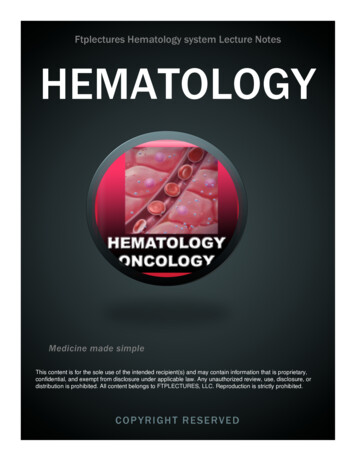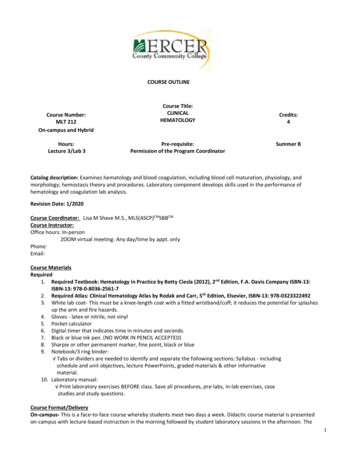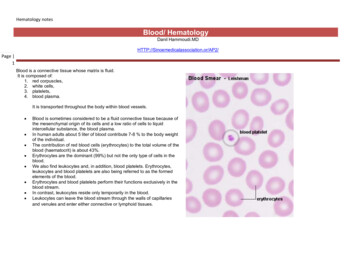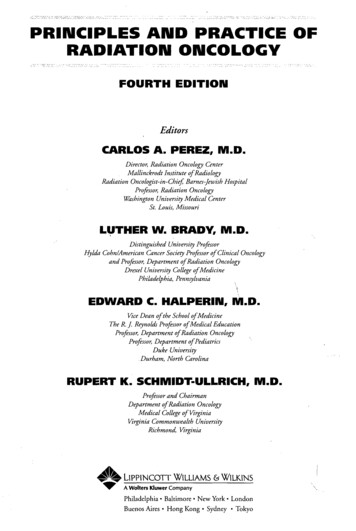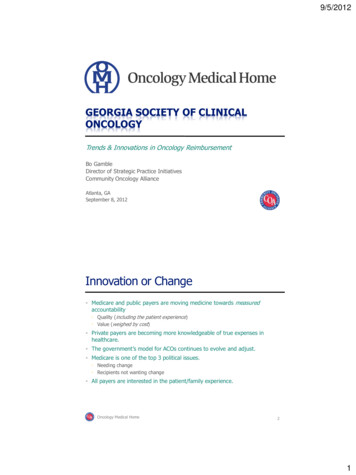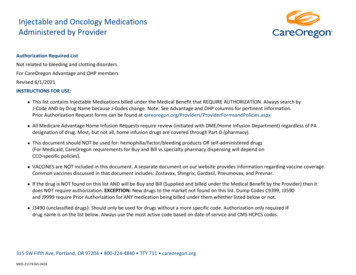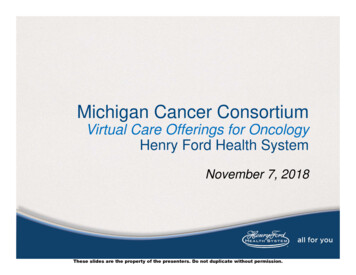
Transcription
Callahan Cancer CenterHematology & Oncology Services2016AnnualReportCompassionate Cancer Caregphealth.org/callahancancer
The Callahan Cancer Center Compassionate Cancer CareGreat Plains HealthCallahan Cancer CenterThe Callahan Cancer Center ison clinical guidelines for qualityaccredited as a Community Canceroncology care. Only practices70Program by the American Collegethat meet or exceed a definedof Surgeons Commission on Cancerlevel of performance may achieve(ACoS, CoC) under the CancerQOPI Certified status. To achieveProgram Standards: Ensuringcertification, a practice undergoesof all newly diagnosedPatient-Centered Care. More thana thorough assessment of policies70 percent of all newly diagnosedand processes, as well as an on-sitecancer patients are treated in thesurvey.%cancer patients aretreated in the morethan 1,500 CoCaccredited cancerprograms nationwide.more than 1,500 CoC-accreditedcancer programs nationwide. Thisaccreditation must be renewedwith a comprehensive surveyevery three years. The Great PlainsHealth Callahan Cancer Center isproud of the work and effort putforth by all the team members ofour cancer program to maintainthis accreditation, showing ourdedication to quality care forevery patient.The Callahan Cancer Center isalso proud to have achievedQOPI (Quality Oncology PracticeInitiative) Certification. There areonly 276 QOPI-certified practicesin the United States. The QOPICertification Program incorporatesmeasures and standards basedThe Joint Commission grantedGreat Plains Health a three-yearaccreditation after a successfulsurvey for all services coveredunder the ComprehensiveAccreditation Manual for Hospitals.An independent, not-for-profitorganization, The Joint Commissionaccredits and certifies more than20,500 health care organizationsand programs in the United States.The Joint Commission accreditationand certification is recognizednationwide as a symbol of qualitythat reflects an organization’scommitment to meeting certainperformance standards.
Welcome to the Great PlainsHealth 2016 cancer reportDavid G. Lindley, MDComplete Family MedicineChairman, Cancer CommitteeWelcome to the Great Plains Health 2016 Cancerthat people who eat fewer fruits and vegetablesReport. This year, we have chosen to focus onare at a greater risk of developing prostateprostate cancer. Prostate cancer is the mostcancer. Some chemicals, such as Agent Orange,common cancer in American men except forused during the Vietnam War, also increaseskin cancer. Each year, approximately 180,000people’s risk of developing prostate cancer.new cases of prostate cancer are diagnosedSmoking and obesity do not seem to be riskin the United States, and there are aroundfactors. Infection in the prostate gland and26,000 deaths from prostate cancer. Thissexually transmitted diseases also do not seemmeans that around one in every seven mento cause an increased risk of prostate cancer. Inwill be diagnosed with prostate cancer duringaddition, having a vasectomy does not increasehis lifetime. Prostate cancer develops mainlya man’s risk of prostate cancer.in older men. At least 60 percent of cases arediagnosed after the age of 65 years. ProstatePreventing cancer, when possible, is always thecancer is rare before the age of 40. The averagebest approach when dealing with any form ofage, in fact, at the time of diagnosis is around 66.cancer. Really, the only informationin terms of prevention ofThe main risk factor for prostate cancer is age.It is also found more commonly in AfricanAmerican men and in Caribbean men. AfricanAmerican men who develop the disease are alsotwice as likely to die of prostate cancer as whitemen. Interestingly, prostate cancer seems lesscommon in Asians and Hispanics. The reasonsfor these differences are unclear. Prostatecancer is also more common in North Americaand Northwest Europe as well as Australia andthe Caribbean islands. The reasons for this arealso unclear.prostate cancer is generaladvice. This wouldinclude eating anappropriate diet,which includesa reasonableamount ofvegetables andfruits each dayand perhapslimiting theAt least 60percent ofcases arediagnosedafter the ageof 65 years.amount of redAs with many cancers, family history ismeat in the diet.important, and certain genetic mutations alsoMost cancer risks areincrease a person’s risk of prostate cancer, suchdefinitely lowered by beingas BRCA-1 and BRCA-2 mutations and Lynchphysically active and staying atsyndrome in men. Diet has been researched ina healthy weight. Even if these measuresterms of being a risk factor for prostate cancer.do not specifically reduce the risk of developingSome studies suggest that eating a lot of redprostate cancer, living with any cancer is easiermeat or high-fat foods will increase the risk ofif the body is physically in a healthy state.prostate cancer. There is also some evidencecontinued on page 6 2016 Annual Report p3
The Callahan Cancer Center Compassionate Cancer CareCancer committeeappointments for 2016Physician membersNon-physician membersDavid Lindley, MDChair, family medicineCancer registry qualitycoordinatorJan Daniel, APRNPalliative careTerry Martin, RN, OCNMedical oncology nurseSusan DeaverDirector of home health& hospiceAmanda Miller,RN, BSN, OCNQuality improvementcoordinatorOyomi Asojo, MDPathologyByron Barksdale, MDPathologyRaymond Carlson, DOPalliative careBrendon Curtis, MDGeneral surgeryKathy Feagler,RN, BSN, OCNDirector of cancer centerCancer programadministratorKim GaaschDirector of pharmacyTammy Niemoth,RN, BSN, OCNMedical oncologyJill Reeves, MS, CTRCancer registrarCancer conferencecoordinatorClark Diffendaffer, MDDiagnostic radiologyPam GarrickCommunity outreachcoordinatorHoward Shaw, MDChief medical officerTodd Hlavaty, MDRadiation oncologyKathy GundersonSocial workerKari Suhr, CTRCerticodeLadd Lake, MDInterventional radiologyMegan HansonMarketing managerRobin StorerChaplainJeremy Larsen, MDMedical oncologyNan Hynes, MSWCase managementPsychosocial servicescoordinatorCelie VaughnNutrition servicesTahir Lone, MDPulmonologyAvinash Pasam, MDMedical oncologyMichael Simonson, MDGeneral surgeryACoS cancer liaisonphysicianIrfan Vaziri, MDMedical directorMedical oncologyJill KochAmerican Cancer SocietyLisa Kosmecek, RNNurse managerClinical researchcoordinatorFiona LibsackVP of marketingand educationShelia Markley, RN, BSN,CBCNNurse navigatorMerry VenezieAdministration secretaryTreg VyzourekSenior director ofancillary services
The role of radiation treatmentof prostate cancerProstate cancer is the cancer of the newThere will be a major impetus to provide datamillennia for men. It has generated the mostthat will show an improvement in the qualitycontroversy of any cancer in regard to the needof life as well as a distinct survival advantage toand criteria for screening, the role of treatmentour treatment. I think we have done this manyand the appropriate follow-up regardingtimes in the past and will continue to provethis disease. This has been reflected in thethis many times in the future. Our clinic isconstant change in NCCN guidelines andpoised to meet this challenge with the adventthe need for treatment of our patients. Oneof new technology and the constant educationconstant in this paradigm is the continuedthat goes with advanced treatment to meet theneed for radiation oncology and the viability ofgoals of an ever-changing health environment.prostatic brachytherapy and definitive externalTodd Hlavaty, MDRadiation Oncology Directorbeam treatment using intensity-modulatedradiation and image-guided treatment.The major change in radiation treatment hasrecently evolved around the major conceptsof normal tissue sparing and dose escalationwith the advent of image-guided treatmentand intensity-modulated treatment. Giventhe current health environment, radiationoncologists will be challenged to deliver costeffective treatments that will provide shorterintervals of treatment with equivalent results inregard to treatment toxicity and overall results.2016 Annual Report p5
The Callahan Cancer Center Compassionate Cancer CareWelcome to the Great Plains Health 2016 cancer report(continued from page 3)Various vitamin and mineral supplements,or frequency of urination, blood in the urinealong with medications, have been suggestedor semen, erectile dysfunction or bone pain,to lower the risk of prostate cancer, such asparticularly in the hips, back or chest. Weaknessselenium and vitamin E, but studies have notor numbness in the legs or feet is also aconclusively shown that these supplements insymptom of advanced prostate cancer. It shouldthe diet are of any benefit.be noted that most of the urinary symptomsare very common simply from benign prostaticDavid G. Lindley, MDComplete Family MedicineChairman, Cancer CommitteeProstate cancerdoes not usuallycause any signsor symptomsuntil later inthe diseaseprocess.Detecting any cancer at an early stage helpsgrowth of the prostate, called BPH, or benignlead to better outcomes. Early detection ofprostatic hyperplasia. This is not cancerousprostate cancer is a topic to discuss with yourand happens almost universally in men as theyfamily practice or primary care provider. Thereadvance in age.are two tests that are available to help withearly detection of prostate cancer. The firstIf you should develop symptoms of prostateone is a blood test for the prostate-specificcancer and are felt to be at high risk, a prostateantigen, or PSA. The other test is a digital rectalbiopsy is a relatively easy test to undertakeexamination, where a doctor inserts a gloved,to make the diagnosis. There are also manylubricated finger into the rectum to feel thetreatment modalities that can be offered forprostate gland for any irregularities.prostate cancer.Unfortunately, there is considerable debateI commend this annual cancer report. Greatbetween different medical sources as to thePlains Health is able to provide a full rangeusefulness of these tests. Neither of these tests,of services for discussions about preventionunfortunately, is reliable for early diagnosisof prostate cancer, along with all treatmentof prostate cancer. The other problem is thatmodalities. The primary care physicians in thethese tests can lead to overdiagnosis andcommunity should be the first people to talk toovertreatment of the disease, which in itselfabout prostate cancer screening and symptoms.can lead to increased morbidity. It is also a factShould a referral be necessary, we have all thethat while prostate cancer is very common, aappropriate specialists available in the Northmajority of people live with the disease withPlatte community to treat this disease close tominimal symptoms and probably are at higherhome, family and friends.risk of morbidity from the treatment than fromhaving no treatment. Therefore, screening toDavid G. Lindley, MDdetect prostate cancer early is a topic that youComplete Family Medicineshould discuss with your primary care providerChairman, Cancer Committeeto decide what the right approach is on anindividual basis.Prostate cancer does not usually cause anysigns or symptoms until later in the diseaseprocess. Early prostate cancer generally hasno symptoms. In more advanced prostatecancer, symptoms can include changes in flow
A systemic approach to thetreatment of prostate cancerIrfan A. Vaziri, MDMedical Oncology DirectorProstate cancer represents about 25 percent of allPatients with systemic disease, if they arenewly diagnosed cancers in males and about ninenoncastrate, have several options for treatmentpercent of cancer-related deaths. There were anavailable, including Sipuleucel-T, abiraterone,estimated 220,000 new cases of prostate cancer andenzalutamide and radium 223 dichloride, and now27,000 deaths in 2015. The disease is lethal for somepatients have these options available prior to gettingmen, although the majority of men with prostatechemotherapy. These options should be discussedcancer die of other causes. Autopsy series havewith the patient prior to starting treatment. Ifshown that nearly 70 percent of men older than agepatients do become castrate resistant, they still80 have occult prostate cancer. This highlights thehave options for treatment post chemotherapybiological and clinical course of prostate cancer,that include cabazitaxel and secondary hormonewhich remains highly variable. Many prostatetherapies, including abiraterone and enzalutamide.cancers do not require immediate intervention, asPatients with symptomatic bone metastases can alsothe risk of death from non-cancer-related causesbe considered for radium 223 dichloride treatments.exceeds that from the cancer. Other prostatecancers require combined modality approaches,An important aspect of patient care is palliativeboth to eradicate the tumor locally and totreatment for pain from bone metastases, which caneliminate metastases.be achieved with external beam radiation therapywith various techniques. Systemic treatments canProstate cancer is classified into clinical statesalso provide palliation. Chemotherapy treatmentaccording to its location. Localized disease,with mitoxantrone and prednisone and two bone-clinical metastases and castration-resistantseeking radiopharmaceutical agents, strontium-89disease each have distinct therapeutic options andand samarium-153, have been shown to reduceprognoses. PSA (prostate-specific antigen) has athe pain of skeletal metastases despite the lack ofrole in the diagnosis and management of prostatesurvival benefit.cancer; however, limitation in the PSA sensitivity,Early detection andspecificity and positive-negative predictive valuesEarly detection and treatment will lead to atreatment will lead tohave led to differing opinions regarding screeningsignificant number of men who could be cureda significant number ofrecommendations. Oncologists generally tend toof prostate cancer by radiation or surgery. Thesesee these patients later in the course of their diseasepatients may have a variety of adverse effects becausewhen the patients present with a rising PSA in theof the treatment, including urinary incontinence,setting of prior local therapy or they have clinicalerectile dysfunction and psychosocial issues.metastases both in the setting of noncastrate orProstate cancer is a disease of predominately oldercastrate disease.men with coexisting medical issues, and hormonemen who could be curedof prostate cancer byradiation or surgery.therapy is associated with numerous adverseThe disease state of rising PSA refers to men whoeffects that are more pronounced in older men.have no detectable metastases on scans and inPatients who receive long-term hormone therapywhom the PSA levels increase after local therapy,may develop insulin resistance, hyperglycemiawhich may include radical prostatectomy orand metabolic syndrome, which may increaseradiation therapy or both. In most cases, a risingcardiovascular mortality. However, systemicPSA represents micrometastatic disease that is notapproaches in the treatment of prostate cancerdetectable on conventional imaging studies. In thiscontinue to improve, and in this particular setting,particular setting, data suggests that intermittentprostate cancer is changing into a chronic disease.androgen suppression is a reasonable alternative tocontinuous antigen suppression without adverselyaffecting survival.2016 Annual Report p7
The Callahan Cancer Center Compassionate Cancer CareScreening for prostate cancerMichael Simonson, MD, CLPSurgeonAmerican College of Surgeons,Commission on CancerCancer Liaison PhysicianProstate cancer has long been an issue ofthe American College of Surgeonssubstantial concern when evaluating theCommission on Cancer database. Thishealth and wellness of our male patients.powerful tool allows hospitals andThere has been significant controversymedical institutions across the country toregarding screening, evaluation andpool data regarding cancer statistics. Thistreatment for this disease over the years.can ultimately help guide our screeningThere has been additional controversyand treatment recommendations.recently due to reports of increasingGreat Plains Health proudly takes partfrequency of prostate cancer over thein the American College of Surgeonspast decade as well as reports of recentCommission on Cancer National Cancerprostate cancer cases being moreDatabase to help provide the mostaggressive in nature.effective methods of cancer treatment forThese findings are established whenevaluating the data provided topatients in our community and acrossthe country.Prostate cancer treatment optionsMillie Pevzner, MDGreat Plains UrologyProstate cancer is among the mostOnce diagnosed, there are multiplecommon malignancies diagnosed in men.treatment options available. The mostUnfortunately, there is no consensuscommon treatment options remainamong professional organizationssurgical removal of the prostate orregarding whether or not to performradiation therapy, which could includeprostate cancer screening. The Americanimplanting radioactive pellets into theUrological Association recommends sharedprostate. Some other options includedecision making regarding the need forcryotherapy or freezing the prostate gland,screening in men with a family history ofhormonal therapy and other experimentalprostate cancer, African-American men,options. Increasingly, some men with aand males aged 55-69. There may below volume of non-aggressive diseaseother indications for or against prostateare opting for close surveillance withoutcancer screening, and this should beactive treatment. Each treatment optiondiscussed with your family doctor orhas different side effects and should beurologist.discussed in detail with your doctor.
2015 annual clinicalresearch reportwritten by:Lisa Kosmacek, RNClinical Research CoordinatorShelia Markley, RNNurse NavigatorGreat Plains Health Callahan CancerThe Lymphoma Study Group RegistryCenter’s medical oncology department isand Tissue Bank through the Universitydedicated to providing the most up-to-of Nebraska Medical Center is anotherdate clinical research for our patients. Ourgroup with which the researchclinical research coordinator, along withcoordinator works to follow patientsour nurse navigator, is responsible fordiagnosed with lymphoma, leukemiakeeping physicians updated on potentialand other related disorders. In 2015,trials, opening new trials, assessing12 new patients consented to be in thepatients for possible enrollment, workingLymphoma Study Group. There arewith the physicians to determine patientcurrently 160 patients in follow-up foreligibility, registering patients for clinicalthe Lymphoma Study Group.trials, following these patients’ progressand treatment on a scheduled basis andTwenty-six patients were accrued todoing all required paperwork for each trial.studies in 2015 at the Callahan CancerCenter. These studies consisted of breastThe research program at Great Plainscancer patients, lymphoma or leukemiaHealth is an affiliate of the University ofpatients, and lung cancer patients. WeNebraska Medical Center and works withcontinue to follow patients who havethe Center to open new studies throughbeen enrolled in past clinical trials untilAlliance for Clinical Trials in Oncologytheir time of death. We are proud of theand keeps all regulatory files current forcontributions we are making to researchall studies. The studies available vary asat the Callahan Cancer Center and theto diagnosis, with breast, lung, colonaccessibility of participation in leading-and prostate being the most commonlyedge treatments for our patients.available studies. There are also studiesopen for patients with diffuse large B-celllymphoma and follicular lymphoma, toname a few. In 2015, we also becameaffiliated with the Missouri Valley CancerConsortium, which provides a number ofclinical trials for all cancers available toour patients to be enrolled in providedthey meet the inclusion criteria.2016 Annual Report p9
The Callahan Can
The Callahan Cancer Center Compassionate Cancer Care 70 % of all newly diagnosed cancer patients are treated in the more than 1,500 CoC-accredited cancer programs nationwide. Great Plains Health Callahan Cancer Center The Callahan Cancer Center is accredited as a Community Cancer Program
